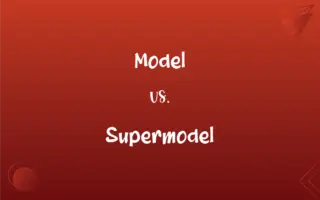Chiral vs. Achiral: What's the Difference?
Edited by Aimie Carlson || By Harlon Moss || Updated on October 23, 2023
A chiral molecule cannot be superimposed on its mirror image, while an achiral molecule can.

Key Differences
A chiral molecule is one that has a non-superimposable mirror image, much like left and right human hands. On the contrary, an achiral molecule is one that is superimposable on its mirror image, meaning the molecule and its mirror image are identical.
In the world of organic chemistry, chiral molecules often contain a carbon atom bonded to four different atoms or groups, creating what's known as a chiral center. Achiral molecules, in contrast, don't have this characteristic. This distinction is significant because the chirality of a molecule can affect its chemical behavior and interactions.
Chiral molecules, due to their unique spatial arrangement, can exhibit different optical activities. They can rotate plane-polarized light either to the left (levorotatory) or to the right (dextrorotatory). Achiral molecules, however, do not exhibit optical activity because their mirror images are superimposable.
It's crucial to understand that chiral and achiral are not just limited to individual molecules. Some larger objects, or even organisms, can exhibit these properties. A good example of chiral objects in everyday life are screws, while spheres represent achiral objects.
Comparison Chart
Mirror Image
Non-superimposable
Superimposable
ADVERTISEMENT
Chiral Center
Contains a chiral center
Lacks a chiral center
Optical Activity
Can exhibit optical activity
Does not exhibit optical activity
Example
Hands
Spheres
Chemical Interactions
Can behave differently based on its spatial arrangement
Behaves the same, regardless of its spatial arrangement
Chiral and Achiral Definitions
Chiral
Objects or molecules not identical to their mirror images.
A screw is an example of a chiral object.
ADVERTISEMENT
Achiral
Molecules identical to their mirror images.
The molecule is achiral and does not exhibit optical activity.
Chiral
Capable of exhibiting optical activity.
Many chiral compounds can rotate plane-polarized light.
Achiral
Objects or molecules superimposable with their mirror images.
A sphere is an achiral object.
Chiral
Molecules with non-superimposable mirror images.
The molecule is chiral due to its unique spatial arrangement.
Achiral
Incapable of exhibiting optical activity.
Even in the presence of plane-polarized light, achiral compounds remain inactive.
Chiral
Contains a chiral center.
The molecule has a chiral carbon atom connected to four different groups.
Achiral
Lacks a chiral center.
The molecule is symmetrical and achiral.
Chiral
Asymmetric in such a way that the structure and its mirror image are not superimposable.
Human hands are chiral, as the left hand cannot be superimposed onto the right.
Achiral
Symmetric in such a way that the structure and its mirror image are superimposable.
A cylinder is an example of an achiral object.
Chiral
Relating to or exhibiting chirality.
Achiral
Superimposable on its mirror image; amphichiral
Chiral
That exhibits chirality (as in the left-handed and right-handed versions of a helix)
FAQs
Can an object be achiral?
Yes, objects like spheres or cylinders are achiral as they're superimposable with their mirror images.
Can achiral molecules rotate plane-polarized light?
No, achiral molecules do not exhibit optical activity.
Can molecules without chiral centers be chiral?
Yes, some molecules exhibit chirality due to their overall shape, not just the presence of chiral centers.
What's the difference between chiral and stereoisomers?
Chiral molecules are a type of stereoisomer, which are molecules with the same molecular formula but different spatial arrangements.
Why are chiral molecules significant in drug design?
Chiral molecules can have different biological activities based on their spatial arrangement.
Can chiral molecules be synthesized?
Yes, chiral molecules can be synthesized, often with the help of chiral catalysts.
What does chiral mean in chemistry?
In chemistry, chiral refers to molecules with non-superimposable mirror images.
Do chiral molecules always have a chiral center?
Most chiral molecules have a chiral center, but not all chiral centers lead to chirality.
How can I identify a chiral molecule?
A common method is to check for a carbon atom bonded to four different atoms or groups.
How do chiral molecules affect light?
Chiral molecules can rotate the plane of plane-polarized light either to the left or the right.
Why is the study of chirality important in medicine?
Because different chiral forms of a drug can have different therapeutic effects or side effects.
Can achiral compounds have chiral conformations?
Some achiral compounds can adopt chiral conformations, but these are typically fleeting and interconvert rapidly.
Are human hands chiral or achiral?
Human hands are chiral.
How many chiral centers can a molecule have?
A molecule can have multiple chiral centers, depending on its structure.
Are all molecules either chiral or achiral?
Yes, molecules are either chiral (non-superimposable on their mirror image) or achiral (superimposable on their mirror image).
Can achiral molecules have chiral centers?
It's possible, but rare, for an achiral molecule to have chiral centers if they cancel out each other's optical activity.
Are there tests to determine if a molecule is chiral or achiral?
Yes, using polarimetry, one can determine if a molecule is chiral by observing if it rotates plane-polarized light.
Is water chiral or achiral?
Water is achiral.
What happens if a chiral molecule has multiple chiral centers?
It can lead to multiple stereoisomers, depending on the spatial arrangement of those chiral centers.
Why don't achiral molecules exhibit optical activity?
Achiral molecules don't have a unique spatial arrangement that would cause them to rotate plane-polarized light.
About Author
Written by
Harlon MossHarlon is a seasoned quality moderator and accomplished content writer for Difference Wiki. An alumnus of the prestigious University of California, he earned his degree in Computer Science. Leveraging his academic background, Harlon brings a meticulous and informed perspective to his work, ensuring content accuracy and excellence.
Edited by
Aimie CarlsonAimie Carlson, holding a master's degree in English literature, is a fervent English language enthusiast. She lends her writing talents to Difference Wiki, a prominent website that specializes in comparisons, offering readers insightful analyses that both captivate and inform.








































































